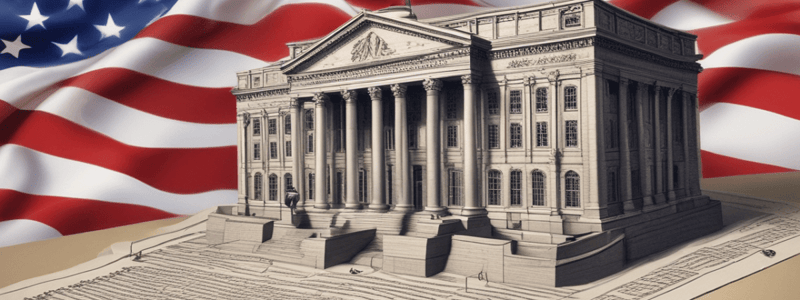Podcast
Questions and Answers
What principle ensures that the national government is balanced by the states?
What principle ensures that the national government is balanced by the states?
- Federalism (correct)
- Checks and balances
- Judicial review
- The Bill of Rights
Which constitutional amendment reserves powers to the states that are not granted to the federal government?
Which constitutional amendment reserves powers to the states that are not granted to the federal government?
- 5th Amendment
- 2nd Amendment
- 1st Amendment
- 10th Amendment (correct)
Which principle protects American citizens' individual rights, including freedom of speech and religion?
Which principle protects American citizens' individual rights, including freedom of speech and religion?
- Separation of powers
- Checks and balances
- The Bill of Rights (correct)
- Judicial review
Which concept divides power between the national government and states, with the national government having specific powers?
Which concept divides power between the national government and states, with the national government having specific powers?
How do the 14th Amendment's due process and equal protection clauses impact individual rights?
How do the 14th Amendment's due process and equal protection clauses impact individual rights?
Flashcards are hidden until you start studying
Study Notes
Limitations of Power on National and State Governments in the U.S. Constitution
The United States Constitution is a unique document in the world of governmental structures due to its dual nature - it both empowers the centralized authority while simultaneously limiting its reach to preserve individual freedoms and rights. This balance between centralization and decentralization is evident when examining the limitations of power on national and state governments within the framework of the American political system. This examination will focus on four specific areas: the separation of powers, checks and balances, federalism, the 10th Amendment, and the Bill of Rights.
Separation of Powers and Checks and Balances
One of the most significant limitations on the power of the national government lies in the principle of the separation of powers. This principle divides the legislative, executive, and judicial functions among three separate branches of government: the Congress, the President, and the Supreme Court, respectively. By doing so, the Constitution ensures that no one branch can become too powerful or dominate the others.
This separation of powers also includes the concept of checks and balances. Each branch has the ability to check the actions of the other two branches, ensuring that no single branch can abuse its powers. For example, the President can veto legislation passed by Congress, but Congress can override this veto with a two-thirds vote in each house. Similarly, the Supreme Court has the power of judicial review, which allows it to strike down laws that violate the Constitution.
Federalism and the 10th Amendment
Federalism is another critical limitation on the power of the national government. It divides power between the federal government and the states, with the national government having specific, enumerated powers, while the states retain all powers not explicitly granted to the federal government. This division of power ensures that the national government is balanced by the states and that the states have a degree of autonomy.
The 10th Amendment, which states that "any power not delegated to the federal government, nor prohibited by the Constitution to the states, is reserved to the states or the people," further reinforces this principle of federalism. This amendment ensures that the states maintain a significant degree of sovereignty and can act independently within the bounds of the Constitution.
The Bill of Rights
The United States Constitution's Bill of Rights is another crucial limitation on the power of the national government. It protects the individual rights of American citizens, such as freedom of speech, religion, and assembly, as well as the protection against unreasonable searches and seizures. These rights are protected from infringement by the national government but can also be applied to state governments through the due process and equal protection clauses of the 14th Amendment.
In conclusion, the American political system's limitations on the power of national and state governments are deeply rooted in the principles of the separation of powers, checks and balances, federalism, the 10th Amendment, and the Bill of Rights. These safeguards ensure that no single branch or level of government can become excessively powerful and that individual rights and freedoms are protected.
Studying That Suits You
Use AI to generate personalized quizzes and flashcards to suit your learning preferences.




